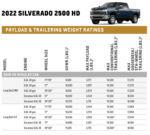The 1999 Ford Ranger is a versatile and capable pickup truck that many owners use for towing. However, to tow safely and effectively, it’s important to understand the truck’s towing capacity limits. In this comprehensive guide, we’ll break down the vital stats, capabilities, and recommendations you need to know about towing with a 1999 Ranger.
An Overview of the 1999 Ford Ranger
The 1999 model year marked the 16th generation of the Ford Ranger, which first debuted in 1982. By 1999, the Ranger had earned a reputation for being a rugged, reliable, and affordable compact pickup.
The 1999 Ranger was offered in three cab configurations:
- Regular cab with a 6-foot bed
- Regular cab with a 7-foot bed
- Extended cab (“SuperCab”) with a 6-foot bed
Two trim levels were available:
- XL
- XLT
There were three engine options available in 1999:
- 2.5L inline 4-cylinder (119 hp, 146 lb-ft torque)
- 3.0L V6 (150 hp, 185 lb-ft torque)
- 4.0L V6 (207 hp, 238 lb-ft torque)
Rear-wheel drive was standard, and 4-wheel drive was optional. Transmission options included 5-speed manual or 5-speed automatic.
Towing Capacity for the 2.5L I4 Engine
The base engine for 1999 was a 2.5L inline 4-cylinder (I4) gas engine. This engine produced 119 horsepower and 146 lb-ft of torque. With this engine, the maximum towing capacity ranged from 1,440 lbs to 2,240 lbs, depending on configuration:
- Regular cab, 2WD, automatic transmission: 2,240 lbs
- Regular cab, 2WD, manual transmission: 1,600 lbs
- SuperCab, 2WD, manual transmission: 1,440 lbs
- Regular cab, 4WD, manual transmission: 1,600 lbs
- SuperCab, 4WD, manual transmission: 1,440 lbs
The gross combined weight rating (GCWR) with the I4 engine was 4,800 to 5,500 lbs.
Towing Capacity for the 3.0L V6 Engine
The optional 3.0L V6 produced 150 horsepower and 190 lb-ft of torque. With this engine equipped, the maximum towing ranged from 2,240 lbs up to 4,360 lbs:
- Regular cab, 2WD, automatic: 4,000 lbs
- Regular cab, 4WD, automatic: 3,860 to 4,360 lbs
- SuperCab, 2WD, automatic: 4,000 lbs
- SuperCab, 4WD, automatic: 3,700 to 4,200 lbs
- Regular cab, 2WD, manual: 2,400 to 2,720 lbs
- Regular cab, 4WD, manual: 2,400 to 2,600 lbs
- SuperCab, 2WD, manual: 2,240 to 2,580 lbs
- SuperCab, 4WD, manual: 2,240 lbs
The GCWR with the 3.0L V6 was 6,000 to 8,000 lbs.
Towing Capacity for the 4.0L V6 Engine
The most powerful engine for 1999 was the 4.0L V6, making 160 hp and 225 lb-ft of torque. This engine delivered the highest tow ratings:
- Regular cab, 2WD, manual transmission: 6,000 lbs
- Regular cab, 4WD, manual transmission: 5,820 lbs
- SuperCab, 2WD, manual transmission: 5,980 lbs
- SuperCab, 4WD, manual transmission: 5,660 lbs
The maximum GCWR with the 4.0L V6 was 9,500 lbs.
Payload Capacities
Payload capacity is also an important consideration for towing. Payload refers to the combined weight of passengers, cargo, and tongue weight from a trailer. The 1999 Ranger had payload capacities ranging from 1,260 lbs to 1,660 lbs, depending on configuration. Always check your door jamb label for the payload capacity of your specific truck.
Towing Equipment and Options
The 1999 Ranger did not come with an integrated trailer tow package from the factory. However, there were some recommended equipment upgrades for owners who planned to do heavy towing:
-
Trailer hitch: Use a Class III or Class IV hitch rated for the appropriate trailer weight. The Ranger can accommodate either a weight-distributing hitch or non-weight distributing hitch.
-
Wiring harness: An aftermarket trailer wiring harness is needed to power trailer lights. Make sure to match connector type to your trailer.
-
Tow mirrors: Extended mirrors help improve rear visibility when towing a wide trailer.
-
Transmission cooler: An auxiliary transmission fluid cooler prevents overheating when towing heavy loads.
-
Upgraded rear springs: Stiffer springs level out squat when towing and carrying heavy cargo.
-
Electric trailer brakes: Required for towing over 1,500 lbs, they provide improved braking performance.
Weight Distribution is Critical
Properly distributing weight is key to safe towing. The trailer tongue weight should be 10-15% of the total loaded trailer weight. Too little tongue weight can cause trailer sway, while too much tongue weight overloads the rear axle. Setting up weight distribution bars helps transfer some of the tongue weight to the front axle.
Payload must also be balanced. With heavy cargo or passengers in the cab, more tongue weight can be tolerated. But with a full cab, tongue weight should be reduced.
Driving Habits for Towing
How you drive while towing a trailer is as important as your setup. Here are some key driving habits to practice:
- Brake early and gradually to avoid trailer sway
- Use lower gears for climbing hills and descending gradually
- Allow extra space for stopping and when merging
- Use firm steering inputs and avoid abrupt maneuvers
- Reduce speed and drive cautiously in challenging conditions
- Take wide turns to accommodate trailer length
Checking Your Specs
The towing capacity can vary based on your individual truck’s GVWR, GAWR, gearing, and other factors. Always refer to your door jamb label and owner’s manual for the ratings of your specific 1999 Ranger. Exceeding the towing or payload capacity risks damage and safety.
Maintaining Your Truck
When towing heavy loads, be diligent about truck maintenance. Follow shortened service intervals, and routinely check brake pads, tire pressure and tread, all fluids, suspension, and steering components. Address any issues promptly to keep your Ranger in top shape.



